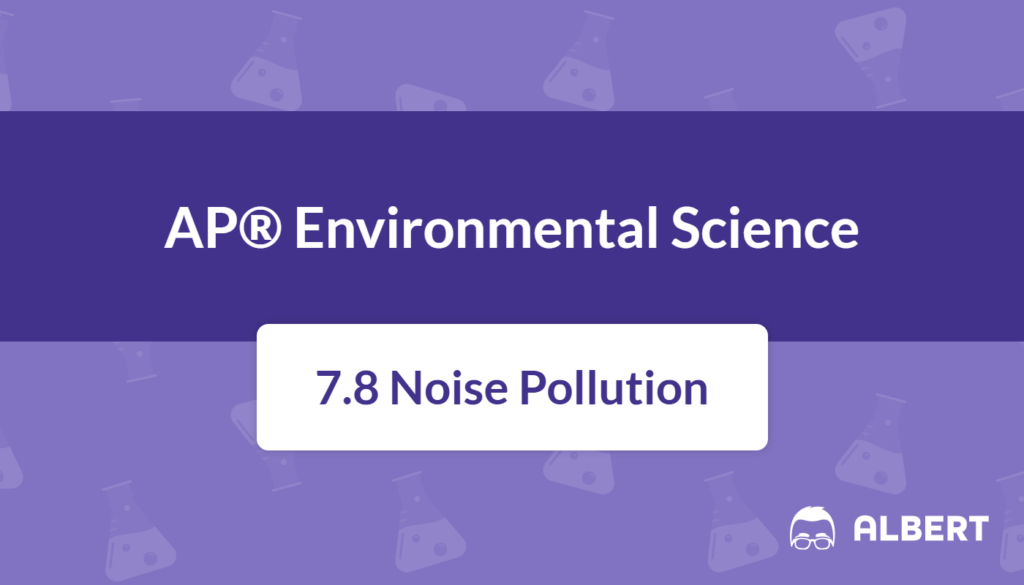What We Review
Introduction
Noise pollution surrounds many urban and industrial areas, yet it often goes unnoticed among more visible environmental challenges. It is a crucial topic because it highlights how human activities can alter soundscapes in ways that harm both people and wildlife. Therefore, examining noise pollution involves understanding its sources, its effects on living organisms, and the methods available to reduce it. This article provides a thorough exploration of noise pollution, including definitions, real-world examples, and clear mitigation strategies.
Many environmental science discussions focus on issues like the carbon cycle or the population growth model. However, noise pollution also represents a serious concern. It refers to harmful or disruptive levels of sound that impair overall health and well-being. Although it lacks the tangibility of land or water pollution, noise pollution still ties directly to human behavior and urban development. It plays a significant role in topics like sustainable living, urban planning, and ecosystem health.
What Is Noise Pollution?
Noise pollution is generally defined as unwanted sound that is high enough to cause physiological stress or hearing loss. Physiological stress may occur when sound levels are overwhelming, leading to adverse health impacts. In addition, repeated exposure to certain sound intensities can result in partial or permanent hearing loss. Study data underscore that chronic exposure to very loud environments can negatively impact physical and mental health over time.
Moreover, sound intensity is commonly measured in decibels (dB), a logarithmic scale representing the ratio of a sound’s intensity to a reference level. The formula for calculating decibels is:
dB = 10 \log \left(\frac{I}{I_0}\right)Here, I stands for the measured sound intensity, and I_0 signifies the reference intensity. For example, a quiet library might measure around 30 dB, while a busy roadway could register above 80 dB. As decibel levels climb, they pose greater risks of hearing loss or stress to people and animals.
Example of Decibel Interpretation
- Identify the measured sound intensity of a source, such as 1 × 10⁻³ W/m².
- Recognize the reference intensity, often 1 × 10⁻¹² W/m².
- Calculate the decibels by inserting these values into dB = 10 \log \left(\frac{I}{I_0}\right).
- Observe how even small increases in the ratio lead to noticeable rises in decibel readings. Thus, a minor difference in intensity can create a much larger perceived loudness.
Sources of Noise Pollution
Urban and industrial activities create most noise pollution, but residential and rural areas can also be affected. Therefore, it is necessary to identify and understand the sources.
- Transportation: Airplanes, trains, trucks, and cars all produce loud, continuous noise. Highways that lack proper sound barriers frequently increase the noise levels in nearby neighborhoods.
- Construction: Power tools, excavation, and heavy machinery often generate intense sound waves, especially in large building projects. Construction noise can sporadically affect people living or working close to the site.
- Domestic Activities: Lawn mowers, leaf blowers, and loud music are part of everyday life. However, they collectively raise ambient noise levels.
- Industrial Activities: Factories, power plants, and industrial facilities usually operate machines that emit loud sounds. In areas with minimal regulation, these sounds can reach hazardous decibel levels.
Real-World Examples
- Urban Roadways: In a busy metropolitan region, daily traffic leads to continuous exposure to noise. Individuals living near these roads tend to have higher reports of sleep disturbances.
- Airports: Communities located under flight paths often endure consistent overhead noise. This can cause annoyance and possible stress-related health issues.
- Industrial Zones: Metal fabrication plants and large-scale assembly factories can produce prolonged noise that affects workers and nearby residents.
These examples confirm that multiple sectors contribute to noise pollution. Additionally, unregulated noise levels can create a ripple effect throughout communities, leading to wide-ranging environmental concerns.
Effects of Noise Pollution on Humans
Noise pollution affects humans in many ways, both physically and mentally. Prolonged exposure to high decibel levels can cause physiological stress, a body’s response to harmful or challenging environmental conditions. Over time, stress can strain the cardiovascular and nervous systems.
Physiological Stress
Physiological stress may manifest as elevated heart rates, anxiety, and an increase in cortisol levels. When these stress responses occur frequently, chronic conditions such as hypertension can develop. Evidence from several urban studies indicates a link between living in noisier environments and experiencing persistent stress symptoms.
Hearing Loss
Hearing loss arises when hair cells inside the inner ear incur damage due to loud noises or extended exposure. According to recent data, more than 10 million people worldwide are at risk of hearing impairment because of noise pollution. Common signs include reduced ability to detect high frequencies and difficulty comprehending speech. Unfortunately, noise-induced hearing damage often goes unnoticed until it becomes severe.

Impact on Daily Life
Excessive noise can also disrupt daily activities by affecting sleep quality. Interrupted sleep may interfere with focus and productivity, leading to reduced performance in work or school settings. Additionally, individuals might experience irritability or mood swings when exposed to high noise levels for extended periods. Therefore, controlling noise pollution is not only a matter of physical health; it also concerns overall well-being.
Effects of Noise Pollution on Animals
Wildlife faces unique challenges from noise pollution because animals depend heavily on sound for communication, navigation, and hunting. Consequently, loud environments can alter their behavior, shift habitats, and even influence survival rates.
Stress and Behavior Changes
Much like humans, animals can exhibit stress responses to elevated noise levels. Sudden sounds from airplanes or industrial sites can cause flight behaviors or disrupt feeding times. Prolonged noise disturbances might lead to habitat abandonment, contributing to population declines in the most vulnerable species.
Masking of Communication Sounds
Many species rely on vocalizations to find mates, signal danger, or coordinate group movements. Noise pollution can mask these critical sounds, causing confusion and reducing reproductive success. For instance, marine mammals depend on echolocation. However, shipping traffic and offshore drilling produce underwater noises that interfere with their sonar system, making it more difficult to locate food or family groups.
Example: Changes in Migratory Routes of Birds
- Birds traveling long distances often rely on auditory cues to stay on course.
- Increased noise levels from busy streets or factories can disrupt these cues.
- Over time, affected bird species may alter their routes or avoid previously used stopovers.
- These changes lead to shifts in local ecosystems, as birds may no longer visit areas once integral to their migratory patterns.
Mitigation Strategies
Reducing noise pollution improves public health, preserves wildlife, and fosters more sustainable communities. Different strategies exist at both individual and community levels. These methods, if well implemented, can reduce decibel levels and help prevent further environmental damage.
Soundproofing Homes
Residents can upgrade windows and doors to more sound-absorbent materials. Insulation with noise-reducing qualities can help keep unwanted external sounds out of living spaces. Additionally, installing barriers such as fences or acoustic panels around properties diminishes incoming noise. Over time, these small-scale improvements can make indoor environments significantly more peaceful.
Urban Planning for Noise Reduction
City planners play a central role in designing quieter societies. Introducing green belts, erecting noise barriers along highways, and zoning residential districts away from major transportation routes are all effective measures. Moreover, establishing strict regulations around construction times can minimize noise disturbances for local communities.
Use of Quieter Machinery and Vehicles
Ongoing efforts by manufacturers to develop quieter engines and equipment contribute to long-term noise reduction. Electric vehicles, for instance, produce lower sound levels compared with conventional cars. Similarly, advanced machinery in construction sites can operate with additional mufflers or use technologies designed to reduce vibrations. By promoting these innovations, communities can lower ambient noise for future generations.
Conclusion
Noise pollution is an underrecognized but important environmental factor. Its capacity to cause physiological stress, hearing loss, and negative impacts on wildlife underscore the need to manage noise levels carefully. Transportation, construction, domestic activities, and industrial processes are major contributors that must be addressed. Fortunately, numerous strategies exist, ranging from insulating homes to careful land-use planning.
Recognizing the importance of noise pollution helps students succeed by reinforcing the idea that any form of environmental disruption—whether it is air, water, land, or noise—can have diverse, far-reaching consequences. Whether it involves better technology, stricter policies, or more informed communities, reducing noise pollution can safeguard human health and protect ecological systems for the future.
Key Vocabulary
- Noise Pollution: Unwanted or harmful sound at levels high enough to cause physiological stress or hearing loss.
- Physiological Stress: A body’s harmful response, such as elevated heart rate, triggered by challenging external factors.
- Hearing Loss: A partial or total inability to hear sounds, often resulting from extended exposure to loud environments.
- Decibel (dB): A logarithmic unit of measurement indicating the intensity of sound compared to a reference level.
- Urban Planning: The process of designing city layouts and systems to optimize the built environment and reduce problems like noise pollution.
Sharpen Your Skills for AP® Environmental Science
Are you preparing for the AP® Environmental Science test? We’ve got you covered! Try our review articles designed to help you confidently tackle real-world AP® Environmental Science problems. You’ll find everything you need to succeed, from quick tips to detailed strategies. Start exploring now!
- AP® Environmental Science: 7.5 Review
- AP® Environmental Science: 7.6 Review
- AP® Environmental Science: 7.7 Review
Need help preparing for your AP® Environmental Science exam?
Albert has hundreds of AP® Environmental Science practice questions, free response, and full-length practice tests to try out.








